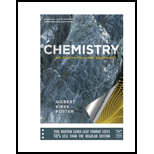
To:
a. Balance the chemical equation.
b. Find out the composition of gehlenite.
Answer to Problem 18.104QA
Solution:
a. The balanced chemical equation is
b. The composition of gehlenite is:
Explanation of Solution
1) Concept:
The reaction is balanced by taking an inventory of the atoms on both sides of the reaction. The
The composition of the metals and the metalloid oxides is found out by first finding how many number of moles of the respective metals and oxides are present. The number of moles will give us the amount of the metal or oxide is present, which can be then divided by the total weight to get the percentage composition. The mineral gehlenite can be written in the form of oxides as
Hence, 1 mole of gehlenite contains two moles of calcium oxide, and one mole each of aluminum oxide and silicon oxide. In terms of metals, gehlenite contains two moles of calcium, two moles of aluminum and one mole of silicon.
2) Formula:
3) Given:
i) Unbalanced
ii) Molar mass of
iii) Molar mass of
iv) Molar mass of
v) Molar mass of
4) Calculations:
a)
The unbalanced equation is
Taking an inventory of the atoms, we get
To balance the
Taking an inventory of the atoms, we get
To balance the
Taking an inventory of the atoms, we get
The reaction is now completely balanced.
The final balanced reaction is
Molar mass of gehlenite
Molar mass of
Molar mass of
Molar mass of
The percentage of
The percentage of
The percentage of
Now, the percentage of calcium metal in gehlenite is
The percentage of aluminum metal in gehlenite is
The percentage of silicon metal in gehlenite is
Thus the percentages of metal and metalloid oxides are
Conclusion:
The percentage composition of the metals and metalloid oxides is determined using the molar mass of the respective metals and oxides.
Want to see more full solutions like this?
Chapter 18 Solutions
Chemistry: An Atoms-Focused Approach
 ChemistryChemistryISBN:9781305957404Author:Steven S. Zumdahl, Susan A. Zumdahl, Donald J. DeCostePublisher:Cengage Learning
ChemistryChemistryISBN:9781305957404Author:Steven S. Zumdahl, Susan A. Zumdahl, Donald J. DeCostePublisher:Cengage Learning ChemistryChemistryISBN:9781259911156Author:Raymond Chang Dr., Jason Overby ProfessorPublisher:McGraw-Hill Education
ChemistryChemistryISBN:9781259911156Author:Raymond Chang Dr., Jason Overby ProfessorPublisher:McGraw-Hill Education Principles of Instrumental AnalysisChemistryISBN:9781305577213Author:Douglas A. Skoog, F. James Holler, Stanley R. CrouchPublisher:Cengage Learning
Principles of Instrumental AnalysisChemistryISBN:9781305577213Author:Douglas A. Skoog, F. James Holler, Stanley R. CrouchPublisher:Cengage Learning Organic ChemistryChemistryISBN:9780078021558Author:Janice Gorzynski Smith Dr.Publisher:McGraw-Hill Education
Organic ChemistryChemistryISBN:9780078021558Author:Janice Gorzynski Smith Dr.Publisher:McGraw-Hill Education Chemistry: Principles and ReactionsChemistryISBN:9781305079373Author:William L. Masterton, Cecile N. HurleyPublisher:Cengage Learning
Chemistry: Principles and ReactionsChemistryISBN:9781305079373Author:William L. Masterton, Cecile N. HurleyPublisher:Cengage Learning Elementary Principles of Chemical Processes, Bind...ChemistryISBN:9781118431221Author:Richard M. Felder, Ronald W. Rousseau, Lisa G. BullardPublisher:WILEY
Elementary Principles of Chemical Processes, Bind...ChemistryISBN:9781118431221Author:Richard M. Felder, Ronald W. Rousseau, Lisa G. BullardPublisher:WILEY





